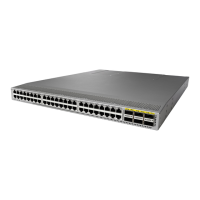Send document comments to nexus3k-docfeedback@cisco.com
9-12
Cisco Nexus 3000 Series NX-OS Unicast Routing Configuration Guide, NX-OS Release 5.0(3)U1(1)
Chapter 9 Configuring Layer 3 Virtualization
Verifying the VRF Configuration
Setting the VRF Scope
You can set the VRF scope for all EXEC commands (for example, show commands). This automatically
restricts the scope of the output of EXEC commands to the configured VRF. You can override this scope
by using the VRF keywords available for some EXEC commands.
To set the VRF scope, use the following command in EXEC mode:
To return to the default VRF scope, use the following command in EXEC mode:
Verifying the VRF Configuration
To display the VRF configuration information, perform one of the following tasks:
Configuration Examples for VRF
This example shows how to configure VRF Red, add an SNMP server to that VRF, and add an instance
of OSPF to VRF Red:
Command Purpose
routing-context vrf
vrf-name
Example:
switch# routing-context vrf red
switch%red#
Sets the routing context for all EXEC commands.
Default routing context is the default VRF.
Command Purpose
routing-context vrf default
Example:
switch%red# routing-context vrf default
switch#
Sets the default routing context.
Command Purpose
show vrf [vrf-name] Displays the information for all or one VRF.
show vrf [vrf-name] detail Displays detailed information for all or one VRF.
show vrf [vrf-name] [interface interface-type
slot/port]
Displays the VRF status for an interface.

